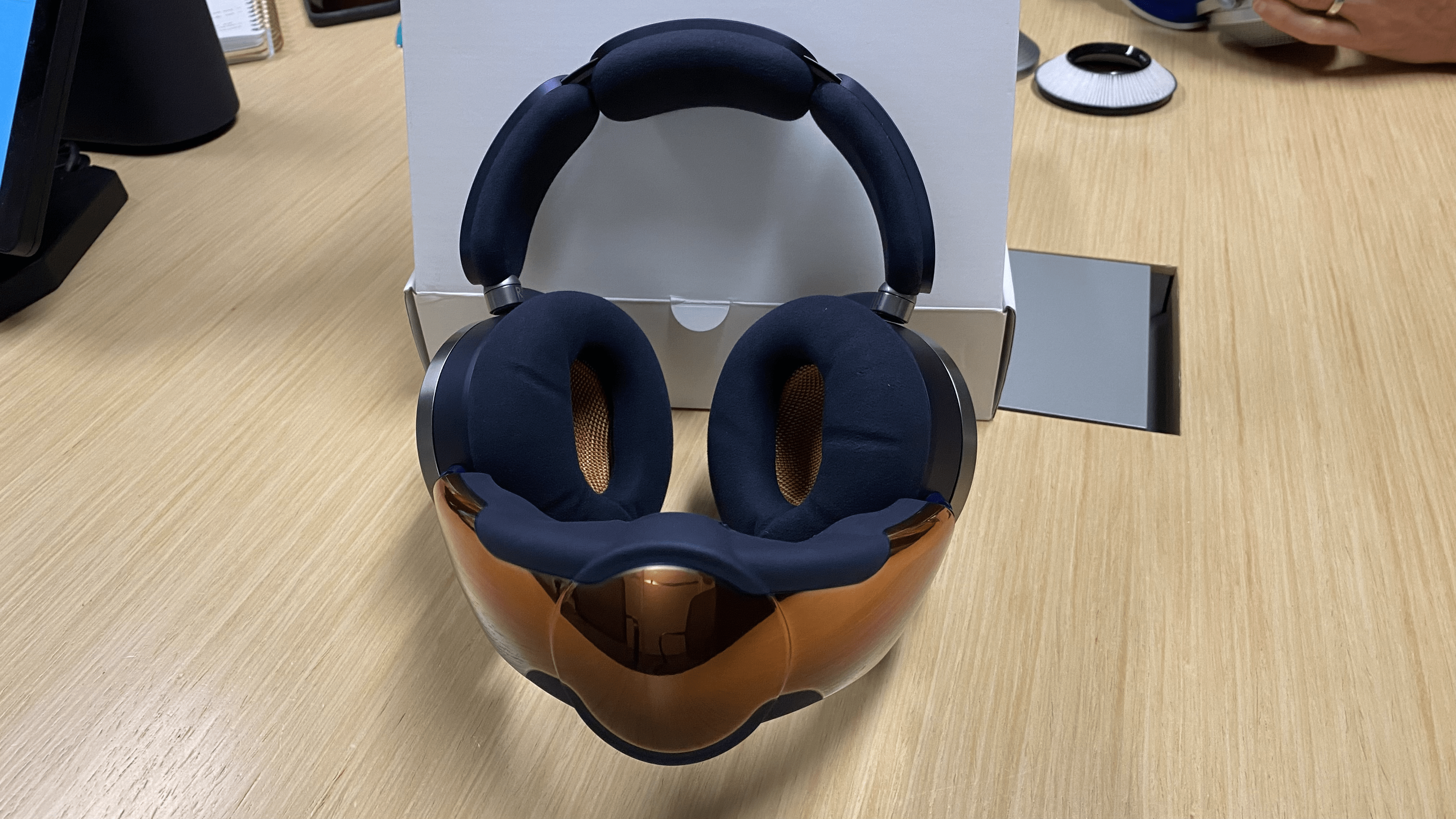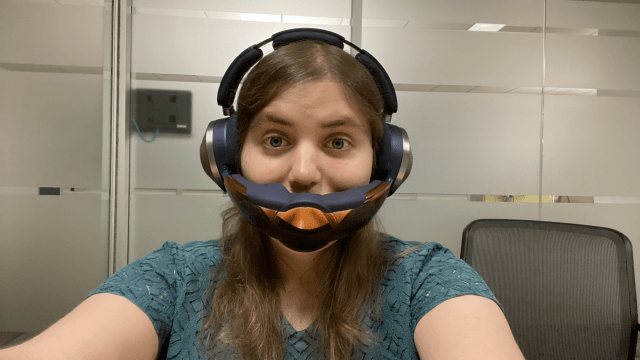Last week, we got a staggering reveal for Dyson’s first-ever audio product, the Zone. The combination headphones-air-purifier will already cost you your privacy, as folks are bound to shoot stares at you from across the train or plane while you’ve got it on. But it’ll also run you $US950 — at least.
Dyson is known for its premium pricing, but we still don’t have Aussie pricing for its first headphones. This review comes from the U.S.
I say “at least” because I had a demo today where I got to try on the “premium” version of the Zone, which comes in a unique navy blue and bronze colourway, and also nets you a leather carrying case and extra filters. When you’re already throwing around hundreds of dollars, an extra $US50 doesn’t sound like much. But now you can at least tell family members that your headphones cost an even $US1,000 (OK, $US999) and see their reactions. And that’s not including accessories like the N95 mask attachment.
For that eye-watering price, you’ll be getting 8-10 mic active noise cancelling (ANC), depending on whether you have the air purifier on, and a promised 50 hours of battery life. Running the purifier drastically shortens that lifespan to 1.5 – 2.5 hours, depending on its speed. But the benefit you can’t put a price on, the piece de resistance here, is the Bane cosplay that comes with the detachable air purifier. It works with filters in the ear cups to push fresh air into your mouth and nose at 10,000 RPM as you confront your nemesis, Batman.

Trying on the Dyson Zone
So what was it like to break the Bat?
Dyson’s been working on The Zone for six years, long before the first cough of the COVID-19 pandemic, and yet the headset still feels at odds with itself… and now the times. With the purifier visor detached, the headphones felt properly hefty without actually hurting my head, despite their 0 kg weight (the AirPods Max weigh a half pound less), but the purifier visor attachment is bizarrely flimsy in comparison, despite bringing the weight up to 1.48 pounds when attached. That’s purposeful, as the purifier needs to be able to twist and bend to fit your face, but the shift from aluminium to plastic and nylon is sorely felt. The unfitting combination raises the same question passersby will be asking: why even combine headphones with a portable air purifier?
Dyson’s been cagey about this, telling me in my demo that noise is a type of pollution, too, as if the idea for the purifier came before the headphones. The real reason might have something to do with the headphone form factor simply making a great mount for the purifier, or the presence of ear cups making a good place to hide the purifier’s motors, or ANC being helpful for blocking noise from said motors. But people who want great audio won’t necessarily want the air purification, and vice versa, so selling them as one product raises the price for both functions without extending the value of either thing. Especially given the difference in build quality, and thus material cost, between the sturdy headphones and thin, plasticky purifier visor attachment.

Some positives: each part of the Zone, individually, works well. The purifier visor itself is especially impressive. It works alongside an app that reads external air quality, and while the already heavily filtered office where I had my demo read as “good quality” to begin with, the fresh air felt noticeably lighter and smelled better, and the fan pushing it towards me never felt annoying or too cold on my face. Your face is exposed when wearing this, by the way, so don’t expect it to block COVID without the N95 attachment.
The angle at which the purifying visor sits is also adjustable, as is how far it sits from your face, and you can quickly pull the whole purifier visor down if you want to get it out of the way without removing the whole attachment (this also swaps the headphones into transparency mode, as the device assumes you’re taking the visor down to talk). The three speed presets are reasonably different and cover a wide variety of use cases, while an auto mode uses an accelerometer inside the Zone to adjust the purifier’s speed depending on how much you’re moving, both for convenience and to save battery life. The health benefits behind this kind of personal air filtration are unclear, but from an experiential standpoint, I could see it making a long plane ride or a walk through a trash-strewn New York street more bearable.

The headphones are also comfortable, and while Dyson didn’t give me driver or audio codec specs, music playing through Spotify exceeded the quality I normally get on the Sennheiser headset I use at home ($US180 ($250), but also wired and without ANC or an air purifier). The Zone’s active noise cancelling is, subjectively, less robust than on its Apple or Sony competitors, but for Dyson’s debut audio product, it’s impressive. Noise cancelling is also great to have if you’re running the purifier, as 2 mics are dedicated purely to blocking out the noise from it, and they work flawlessly. If only they could block the fan noise your fellow commuters will hear, too. While I didn’t get to test how noisy the Zone is to those around you, you can definitely hear the purifier running if you’re wearing the Zone and don’t have active noise cancelling on.
The Zone’s audio controls work via a directional joystick, which gives you easy access to pause/play/skip and to your phone’s digital assistant, but active noise cancelling controls are the one pain point here, and that’s a pretty nasty pain point to have. You’re supposed to be able to swap between ANC and transparency by double tapping either of the headphone’s ear cups, sending an input to an accelerometer inside, but this only worked on about a fifth of my attempts. I’m confident this is something that can be fixed with tuning, but for now, I had to resort to the app to swap ANC and transparency, which is not something I want to bother with on a crowded train.
At the very least, the headset’s considerable weight is well-distributed, and you can easily and precisely adjust the notched headband.

Issues with the Dyson Zone
It’s a shame how clunky using both of these mostly well-designed devices at the same time can be, especially given the Zone’s price as a whole. Actually attaching the air purifier visor to the Zone was an exercise in frustration, as it requires precise placement into slots on either ear cup, but also will not easily attach unless both sides of the headset are pulled far away from each other. This makes it best to attach the purifier visor while you’re already wearing the headphones, meaning you’ll have to fumble blindly to properly slot it in. You can try to put the purifier on before you’re wearing the headphones, but the ear cups will want to pull in towards each other, often undoing your work. You’d need three hands to successfully manoeuvre it.
And because the purifier attachment snaps into slots on the headset, it’s easy to get long hair snagged in it while you’re attaching it to the headphones. I actually lost some hair during my demo. When I took off the purifier off, a clump of my hair went with it.

It’s not just the two core pieces that have problems attaching, though. In the time since the product was conceived, we’ve gone from walking around with naked faces to masking while in public. Masking isn’t as common as it was last year, but it’s still an encouraged practice in some places, and something I’m willing to bet the target audience for a personal air purifier would be interested in. You can use the Dyson Zone with a mask, but it’s not easy, and the result may not be worth it.
As it stands right now, the N95 mask add-on you can buy with your Zone comes in two pieces. One needs to sit underneath a slot on the purifier attachment, which means you’ll need to slightly disassemble it first. It’s a lot of plastic to deal with, and none of the add-ons have guides for fitting everything together, at least in pre-release. Even with Dyson helping me, it took about 20 minutes to get the mask add-on properly attached, and the result was a lessened air flow. That’s to be expected, but it made masking and wearing the air purifier feel not worth the effort. In its current state, it’s probably best to choose one or the other.

Is the Dyson Zone ready?
Most of the problems I identified feel like early issues that could still be ironed out by the time the product launches, but as it stands, this is not the convenience or integration I’d expect from a nearly (or exactly, with the bundle) $US1,000 pair of headphones that justifies its price with an ability to work in tandem with an air purifier. In many ways, these feel like two great but separate products awkwardly taped together. I wouldn’t be surprised if Dyson eventually sells them individually in the future.
If you want to see the chimera in its early state, though, you can pre-order the Dyson Zone via an appointment at a Dyson store in March, 2023. Alternately, the Zone will be coming to Best Buys and online storefronts on April 1st. Yes, really. We’re excited to see how well-tamed the beast will be in our full review.
